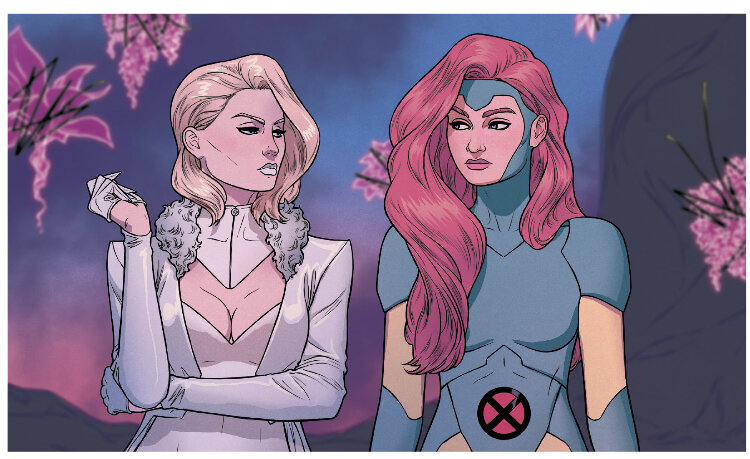The Beginning
“The Beginning”
X-Men #21
Written by Jonathan Hickman
Art by Nick Dragotta, Russel Dauterman, Lucas Werneck, and Sara Pichelli
Color art by Frank Martin, Matthew Wilson, Sunny Gho, and Nolan Woodard
• This issue marks the end of Jonathan Hickman’s run on this particular title, though not the end of his X-Men run – his Inferno miniseries will launch in September and pick up on the Mystique/Moira and Orchis threads of the previous issue, and I strongly suspect there’s another thing coming before year’s end that won’t be announced until after next week’s Planet Size X-Men special. A new X-Men series by Gerry Duggan and Pepe Larraz starring the team introduced in this issue will launch next month, and I haven’t decided whether or not I will cover that on an issue-to-issue basis or simply write about it in chunks as I do all the non-Hickman titles.
• At this point I’m inclined to think that Hickman’s story isn’t following a standard three act structure as much as it’s working on a more musical logic – House of X/Powers of X is an overture establishing themes, and this issue is the end of a movement that began with the first issue of this series but also included his New Mutants issues, the Giant Size specials, and the entirety of X of Swords.
The overall structure of this phase includes motifs and story sequences that recur like melodies, in this issue we get an echo of the opening of X-Men #1 in which Cyclops recalls how Xavier saved him as a child in the form of Cyclops explaining to, uhhhh… MCU head honcho Kevin Feige… why Xavier’s dream continues to motivate him. It highlights the earnestness of the character, and effectively ends his arc as the central protagonist of this particular series. Cyclops is a true believer who finds his purpose in being an X-Man, and in a new society where there was no longer a formal X-Men team, he just kept making new X-Men groups until finally deciding to formally recreate and reinvent the X-Men. There’s an innocence and optimism to what he and Jean Grey are doing now that was notably missing from the start of this phase, and regaining that spirit is the triumph at the end of this arc.
• The rest of the issue mostly nods cryptically in the direction of plot threads unlikely to feature in Inferno – whatever is going to happen with Mars, Emma Frost seeking some resource from a hidden society in an unnamed city that I’m reasonably certain are being introduced in this issue, and a selection of Sinister Secrets that hint at new developments for Cypher and Sinister, upcoming changes in the membership of the Quiet Council, and “an unknown material of immeasurable worth” in Otherworld. It seems like a lot of plot threads going forward will involve precious resources and competition between various societies, which makes sense as the Reign of X phase is above all else about “expansion,” as Emma puts it in her speech at the Gala.
• The opening scene with Namor, Magneto, and Xavier is a delight, but of course it is – it’s four pages of Namor dialogue written by Jonathan Hickman, the definitive Namor writer. Namor’s presence is mainly to deflate the two heads of state at their own self-congratulatory party, though if it turns out that the mutants do in fact terraform and colonize Mars his boast about controlling 70% of the planet might end up looking like less of a brutal own on them. But the crux of the scene is Xavier not shrinking from Namor asking him “How goes the empire building?” “Well, I think.” The hubris sets in…but an Inferno awaits.
• The issue is broken into four scenes by four artists – longtime Hickman collaborator Nick Dragotta very much at home in a Namor scene that plays to his East of West strengths, the X-Men membership reveal sequence by the slick but somewhat sterile Russell Dauterman, some pages by Lucas Werneck that nicely convey the social dynamic of the Gala, and Sara Pichelli shifting her usual style a bit for the last few pages with Emma Frost at her most theatrical. The shifts in style work this issue – different moods for different parts of the party.
• I don’t love the celebrity cameos, not because they’re celebrity cameos per se, but rather that if you’re doing a big Gala like this it is pretty laughable for it to be mostly unglamorous comedians and older rappers rather than… you know, anyone who you’d actually expect to show up to something along the lines of the Met Gala. You expect Rihanna and Lady Gaga and A$AP Rocky, you get Marc Maron and Patton Oswalt and George R.R. Martin.








